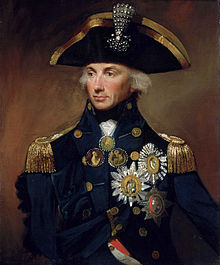Chelengk: Difference between revisions
m →Gifts to non Turkish naval heroes: clean up; http→https for Google Books using AWB |
Rescuing 1 sources and tagging 1 as dead. #IABot (v1.5beta) |
||
| Line 30: | Line 30: | ||
}} |
}} |
||
A '''chelengk''' ({{lang-ota|چـلنك}})<ref name="Ottoman">{{cite web |url=http://www.imanveislam.com/kitaplar/turkce/oku/osmanlicalugat/index.html?page=001/c92.htm |title=Osmanlica Lûgât |trans_title=Ottoman Glossary |language=Turkish |accessdate=11 November 2012 }}</ref> ({{lang-tr|Çelenk}}) was a military decoration of the [[Ottoman Empire]]. |
A '''chelengk''' ({{lang-ota|چـلنك}})<ref name="Ottoman">{{cite web |url=http://www.imanveislam.com/kitaplar/turkce/oku/osmanlicalugat/index.html?page=001/c92.htm |title=Osmanlica Lûgât |trans_title=Ottoman Glossary |language=Turkish |accessdate=11 November 2012 }}{{dead link|date=August 2017 |bot=InternetArchiveBot |fix-attempted=yes }}</ref> ({{lang-tr|Çelenk}}) was a military decoration of the [[Ottoman Empire]]. |
||
==Turkish military award== |
==Turkish military award== |
||
Originally a ''çelenk'' was "a bird's feather which one attaches to the turban as a sign of bravery"<ref>{{cite book |quote=''{{lang|fr|Plume d'oiseau qu'on attache sur le bonnet en signe de vaillance}}'' |authors=[[Abel Pavet de Courteille]], Mahdī Khān Astarābādī and Muḥammed Khuweyyi |url=http://catalog.hathitrust.org/Record/001006232 |title=Dictionnaire Turk-Oriental |publisher=Imprimerie impériale |location=Paris |year=1870 }}</ref> but by the end of the 18th century, the ''{{lang|tr|çelenk}}'' had become institutionalized in Ottoman military practice and continued to be awarded for military merit up to the 1820s.<ref name="obarsiv">{{cite web |url=http://www.obarsiv.com/english/Ottoman_Orders_and_Decorations.html |title=Ottoman Orders and Decorations as Forms of Honor |publisher=Ottoman Bank Archives and Research Centre }}</ref> It was a jewelled [[aigrette]] consisting of a central flower with leaves and buds, and upward-facing rays. |
Originally a ''çelenk'' was "a bird's feather which one attaches to the turban as a sign of bravery"<ref>{{cite book |quote=''{{lang|fr|Plume d'oiseau qu'on attache sur le bonnet en signe de vaillance}}'' |authors=[[Abel Pavet de Courteille]], Mahdī Khān Astarābādī and Muḥammed Khuweyyi |url=http://catalog.hathitrust.org/Record/001006232 |title=Dictionnaire Turk-Oriental |publisher=Imprimerie impériale |location=Paris |year=1870 }}</ref> but by the end of the 18th century, the ''{{lang|tr|çelenk}}'' had become institutionalized in Ottoman military practice and continued to be awarded for military merit up to the 1820s.<ref name="obarsiv">{{cite web |url=http://www.obarsiv.com/english/Ottoman_Orders_and_Decorations.html |title=Ottoman Orders and Decorations as Forms of Honor |publisher=Ottoman Bank Archives and Research Centre |deadurl=yes |archiveurl=https://web.archive.org/web/20120501104355/http://www.obarsiv.com/english/Ottoman_Orders_and_Decorations.html |archivedate=2012-05-01 |df= }}</ref> It was a jewelled [[aigrette]] consisting of a central flower with leaves and buds, and upward-facing rays. |
||
In modern Turkish, a ''{{lang|tr|çelenk}}'' is a wreath or garland, a circular decoration made from flowers and leaves, usually arranged as an ornament. |
In modern Turkish, a ''{{lang|tr|çelenk}}'' is a wreath or garland, a circular decoration made from flowers and leaves, usually arranged as an ornament. |
||
Revision as of 01:26, 4 August 2017
| Chelengk of the Ottoman Empire | |
|---|---|
 Replica of the diamond chelengk | |
| Type | Jewellery |
| Country | Ottoman Empire |
| Eligibility | Civilians and military |
| Status | No longer awarded |
| Established | 1798 |
| Precedence | |
| Next (higher) | Order of Osmanieh |
| Next (lower) | Gallipoli Star |
A chelengk (Ottoman Turkish: چـلنك)[1] (Turkish: Çelenk) was a military decoration of the Ottoman Empire.
Turkish military award
Originally a çelenk was "a bird's feather which one attaches to the turban as a sign of bravery"[2] but by the end of the 18th century, the çelenk had become institutionalized in Ottoman military practice and continued to be awarded for military merit up to the 1820s.[3] It was a jewelled aigrette consisting of a central flower with leaves and buds, and upward-facing rays.
In modern Turkish, a çelenk is a wreath or garland, a circular decoration made from flowers and leaves, usually arranged as an ornament.
Gifts to non Turkish naval heroes

A specially-made chelengk was awarded to Horatio Nelson by Sultan Selim III in honour of the Battle of the Nile in 1798. This was the first time that a chelengk was conferred on a non-Ottoman.[3] The usual seven rays were augmented to thirteen, as described in a contemporary letter:
The Aigrette is a kind of feather; it represents a hand with thirteen fingers, which are of diamonds, and allusive to the thirteen ships taken and destroyed at Alexandria, the size that of a child's hand about six years old when opened; the center diamond and the four round it may be worth about £1000 each, and there are about 300 others well set.[4]
Nelson's chelengk was bought by the Society for Nautical Research in 1929 following a national appeal[5] and placed in the National Maritime Museum from where it was stolen in 1951 and never recovered.[6]
Selim III also gave a chelengk to Russian Admiral Fyodor Ushakov after the capture of Corfu from the French in 1799.
In literature
In Patrick O'Brian's Aubrey–Maturin series of novels, Captain Jack Aubrey is awarded a chelengk by the Sultan after capturing two rebel ships in The Ionian Mission. His chelengk was worn, like Nelson's, on his dress uniform hat and contained hidden clockwork, so that the diamond strands shimmered in the sun.[7]
See also
Sources
- The War for All Oceans: From Nelson at the Nile to Napoleon at Waterloo. Abacus. 2007. p. 38. ISBN 978-0-349-11916-8.
{{cite book}}: Unknown parameter|authors=ignored (help) - "Replica of Nelson's chelengk". National Maritime Museum.
- ^ "Osmanlica Lûgât" (in Turkish). Retrieved 11 November 2012.
{{cite web}}: Unknown parameter|trans_title=ignored (|trans-title=suggested) (help)[permanent dead link] - ^ Dictionnaire Turk-Oriental. Paris: Imprimerie impériale. 1870.
Plume d'oiseau qu'on attache sur le bonnet en signe de vaillance
{{cite book}}: Unknown parameter|authors=ignored (help) - ^ a b "Ottoman Orders and Decorations as Forms of Honor". Ottoman Bank Archives and Research Centre. Archived from the original on 2012-05-01.
{{cite web}}: Unknown parameter|deadurl=ignored (|url-status=suggested) (help) - ^ The Naval chronicle, Volume 1. J. Gold. 1799. p. 340.
{{cite book}}: Unknown parameter|editors=ignored (|editor=suggested) (help) - ^ "The Chelengk of Nelson – Proposed Purchase for the Nation". The Times. London. 8 November 1929. p. 10 (with photograph).
- ^ "The Chelengk". The Art Fund. Retrieved 11 November 2012.
- ^ Patrick O'Brian (2003). Treason's Harbour. HarperCollins. p. 7. ISBN 0-00-649923-6.
